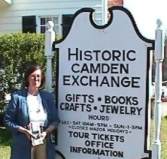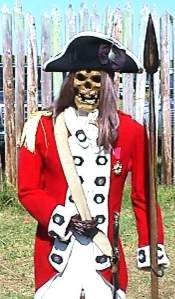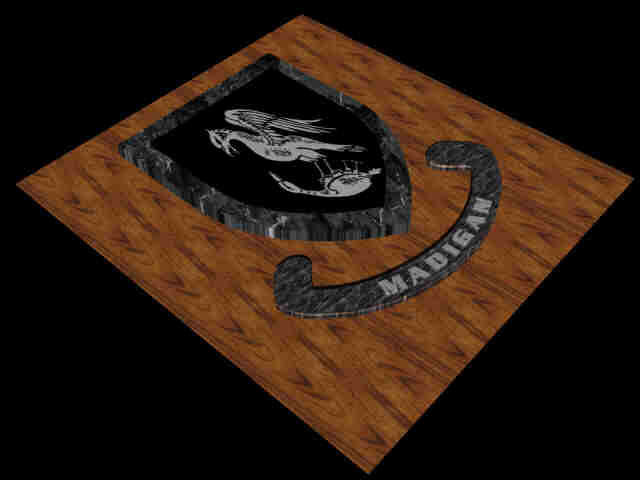A Revolutionary Re-enactment
Camden historical park.
Camden, SC
November 7th, 1999
Camden  is reportedly the oldest existing
inland town in South Carolina. It all started with some
instructions issued by King George II in 1730. These instructions
specified that a township should be created on the River Watery.
Three years later, when done, the town became Fredricksburg
Township. It was later changed to Pine Tree Hill. Many American
towns have their contributing fathers who through their
inspiration and foresight have guided the community into a
prosperous existence. Examples of this can be found in the
persona of Milton Hershey of Hershey, Pa., and Samuel Slater of
Pawtucket, RI. Camden also had its favorite son. Joseph Kershaw
arrived in the area in 1758. Within a short period of time he had
built a grist mill, saw mill and a flour mill. By 1760 the town
had attain
is reportedly the oldest existing
inland town in South Carolina. It all started with some
instructions issued by King George II in 1730. These instructions
specified that a township should be created on the River Watery.
Three years later, when done, the town became Fredricksburg
Township. It was later changed to Pine Tree Hill. Many American
towns have their contributing fathers who through their
inspiration and foresight have guided the community into a
prosperous existence. Examples of this can be found in the
persona of Milton Hershey of Hershey, Pa., and Samuel Slater of
Pawtucket, RI. Camden also had its favorite son. Joseph Kershaw
arrived in the area in 1758. Within a short period of time he had
built a grist mill, saw mill and a flour mill. By 1760 the town
had attain ed a first rank position as an inland center of
population and trade. In 1768, at the suggestion of Kershaw, the
name of the town was changed to Camden in honor of Charles Pratt
(Lord Camden), a British Parliamentary champion of colonial
rights. Although the history of the town's earliest settlers is
somewhat vague, by 1760, with the influx of the Scotch-Irish, a
recognizable town had appeared, made up mostly of log cabins. As
the town grew and prospered, examples of elegance began to
appear. Among them was Joseph Kreshaw's mansion, later to be know
as the Cornwallis House. It was begun in 1777 just prior to the
Revolutionary action in the south. In 1780, after the fall of
Charleston, General Lord Charles Cornwallis led a detachment of
British infantry to Camden to seize
ed a first rank position as an inland center of
population and trade. In 1768, at the suggestion of Kershaw, the
name of the town was changed to Camden in honor of Charles Pratt
(Lord Camden), a British Parliamentary champion of colonial
rights. Although the history of the town's earliest settlers is
somewhat vague, by 1760, with the influx of the Scotch-Irish, a
recognizable town had appeared, made up mostly of log cabins. As
the town grew and prospered, examples of elegance began to
appear. Among them was Joseph Kreshaw's mansion, later to be know
as the Cornwallis House. It was begun in 1777 just prior to the
Revolutionary action in the south. In 1780, after the fall of
Charleston, General Lord Charles Cornwallis led a detachment of
British infantry to Camden to seize the powder magazine and establish a
supply depot for further operations in the area. General
Cornwallis seized the Kershaw mansion and converted it to his
military headquarters. The British would remain, building a
palisade around the town. There was an attempt to dislodge the
British, early in their occupation, with disastrous results.
Finally events in the North would require Cornwallis to move much
of his army out of the area, leaving Lord Francis Rowdon to carry
on. A second attempt to overthrow the garrison would occur with
another victory by the British, however, heavy British losses
forced the abandonment of Camden and brought an end to the
southern campaign. The mansion survived for almost a century
through war, weather, and the changing of hands but during the
Civil War, would finally succumb to the war when it was burned to
the ground in 1865 It was re-constructed in 1977.
the powder magazine and establish a
supply depot for further operations in the area. General
Cornwallis seized the Kershaw mansion and converted it to his
military headquarters. The British would remain, building a
palisade around the town. There was an attempt to dislodge the
British, early in their occupation, with disastrous results.
Finally events in the North would require Cornwallis to move much
of his army out of the area, leaving Lord Francis Rowdon to carry
on. A second attempt to overthrow the garrison would occur with
another victory by the British, however, heavy British losses
forced the abandonment of Camden and brought an end to the
southern campaign. The mansion survived for almost a century
through war, weather, and the changing of hands but during the
Civil War, would finally succumb to the war when it was burned to
the ground in 1865 It was re-constructed in 1977.
Our arrival in Camden was timed to coincide with the opening day
of "Revolutionary War Field Days". This is a week-end
in which Camden's Historic Park is converted into a living museum
where elements of the British Army clash with those of the
Revolutionary army for the Battle of Camden. It is quite a gala
event  and re-enactment, in which the Town
of Camden gets together and produces not one but several
representative companies of British troops. There were the famous
British Grenadiers with their tall hats, and a Scottish company
with their pipes and drums. They were joined by a Hussein company
and supported by a rowdy group of loyalists who did their own
thing. Opposing this complement were the well dressed and
extensively drilled American troops, supported by yet another
band of rebel rousing rogues acting independently in support of
their army. Upon arrival we were introduced to Joanna Craig, the
Park's Director, who gave us a warm welcome and the run of the
park. She took time out to explain the efforts made by the local
residents to make the town and the park a living place of
remembrance. As we walked outside, she showed us the Commons,
located between the Kershaw house and the main portion of Camden.
This area was the scene of numerous military exercises throughout
the years. Occupying British troops used the field as a parade
ground, and the
and re-enactment, in which the Town
of Camden gets together and produces not one but several
representative companies of British troops. There were the famous
British Grenadiers with their tall hats, and a Scottish company
with their pipes and drums. They were joined by a Hussein company
and supported by a rowdy group of loyalists who did their own
thing. Opposing this complement were the well dressed and
extensively drilled American troops, supported by yet another
band of rebel rousing rogues acting independently in support of
their army. Upon arrival we were introduced to Joanna Craig, the
Park's Director, who gave us a warm welcome and the run of the
park. She took time out to explain the efforts made by the local
residents to make the town and the park a living place of
remembrance. As we walked outside, she showed us the Commons,
located between the Kershaw house and the main portion of Camden.
This area was the scene of numerous military exercises throughout
the years. Occupying British troops used the field as a parade
ground, and the  revolutionary
hero The Marquis De Lafayette reviewed troops here in 1825. The
area also served as a center for militia activities and a
mustering point for local volunteers leaving for war. The name of
the water head at the foot of the hill, Muster Spring is a
reminder of the field's military function. On either side of this
unoccupied field were the opposing army encampments. As these
were some of her busiest days, Joanna was quickly pulled away to
direct the movement of one of the participating elements. We had
entered the grounds about a half mile from the Kershaw house
where the British were encamped. Our first exposure was to the
American army and the supporting rabble that camped with them.
While the Army tents were regimented and orderly, the civilian
camp was a scattered mingling of men and women, who very much
looked the part for which they were playing. Tents and covering
of every description lay about while the participants cooked,
drank and sat around smoking their long clay pipes and telling
stories of their daring deeds in other engagements. The food they
cooked was real and so apparently were their appetites. One group
even had a mummified mascot of the enemy stuck on a post which
received ample repute and ridicule from the passersby. In our
roving,
revolutionary
hero The Marquis De Lafayette reviewed troops here in 1825. The
area also served as a center for militia activities and a
mustering point for local volunteers leaving for war. The name of
the water head at the foot of the hill, Muster Spring is a
reminder of the field's military function. On either side of this
unoccupied field were the opposing army encampments. As these
were some of her busiest days, Joanna was quickly pulled away to
direct the movement of one of the participating elements. We had
entered the grounds about a half mile from the Kershaw house
where the British were encamped. Our first exposure was to the
American army and the supporting rabble that camped with them.
While the Army tents were regimented and orderly, the civilian
camp was a scattered mingling of men and women, who very much
looked the part for which they were playing. Tents and covering
of every description lay about while the participants cooked,
drank and sat around smoking their long clay pipes and telling
stories of their daring deeds in other engagements. The food they
cooked was real and so apparently were their appetites. One group
even had a mummified mascot of the enemy stuck on a post which
received ample repute and ridicule from the passersby. In our
roving,
